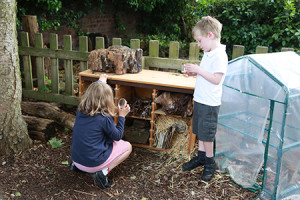by an anonymous Upstart supporter and Educator in Childhood Practice
In business, the ‘Unattainable Triangle’ refers to the impossible task of providing customers with a service that includes quality, cheap costs and speed in equal measure. Apparently, if such a business existed, it would be inherently flawed. In the real world, if we want something fast but high quality, it will cost a lot. If we want something fast and cheap then quality will suffer, and so on. Everything in the business of making money must navigate this triangle.
The Scottish Government’s 2020 blueprint, a vision for an expansion that will almost double entitlement to free early learning and childcare (ELC) to 1140 hours per year by 2020 for all 3 and 4 year olds and eligible 2 year olds, sets out plans to achieve the expansion whilst increasing the quality of care. I don’t like comparing ELC with the business world but unfortunately that is the position we are in. What I want to explore briefly here are some of the things that have and will be sacrificed in this roll-out.
 Whether you work in a nursery, a school, a local authority or college, you will have been feeling the effects of this, some would say, overly-ambitious plan for a while now. You may have lost excellent colleagues, your job title may have changed several times already, hours drastically changed, increased student intake to breaking point, wrangled with architects on how to adapt space in an already overwhelmed indoor nursery, unconvincingly reassured staff of their jobs, I could keep on naming challenges. The lack of actual funding or planning from the government to support the staff in preparing for this doubling of provision across Scotland has tested even the most dedicated early years advocate.
Whether you work in a nursery, a school, a local authority or college, you will have been feeling the effects of this, some would say, overly-ambitious plan for a while now. You may have lost excellent colleagues, your job title may have changed several times already, hours drastically changed, increased student intake to breaking point, wrangled with architects on how to adapt space in an already overwhelmed indoor nursery, unconvincingly reassured staff of their jobs, I could keep on naming challenges. The lack of actual funding or planning from the government to support the staff in preparing for this doubling of provision across Scotland has tested even the most dedicated early years advocate.
The roll-out was given a four year window,  a government term, conveniently ending just before elections. I can’t seem to find information that states that this was a decision based on the actual length of time planning and implementation for such a project would take, but it’s an enormous undertaking in such a short space of time. An unprecedented increase in staff to double the ELC provision is necessary: therefore the past few years have been spent trying to push as many people through training as quickly as possible to meet the demand.
a government term, conveniently ending just before elections. I can’t seem to find information that states that this was a decision based on the actual length of time planning and implementation for such a project would take, but it’s an enormous undertaking in such a short space of time. An unprecedented increase in staff to double the ELC provision is necessary: therefore the past few years have been spent trying to push as many people through training as quickly as possible to meet the demand.
The government has been providing colleges and universities with additional funding to increase their intake and provision for HNC-trained practitioners as well as Level 8 and 9 supervisory and management courses in Childhood Practice. Along with SSSC certification, this should ensure that there is a trained workforce in place, increasing skills and knowledge.
If anyone is not familiar with the SQA’s combined HNC and SVQ course, it was re-written a few years ago and now includes contemporary research, leadership and neuroscience across the whole set of units. The course has great elements but barely enough time to teach it all.  Two years would be a more realistic goal, giving the students time to develop and grow holistically, especially as they will be working with children who have been through challenging transitions due to the expansion. In order to meet government demand, further condensed courses are being offered; speed increases, costs reduce but so does quality of training. The Finnish understand this and require degree level courses for practitioner posts. Scotland now has a Level 9 qualification but at the moment this is reserved for managers.
Two years would be a more realistic goal, giving the students time to develop and grow holistically, especially as they will be working with children who have been through challenging transitions due to the expansion. In order to meet government demand, further condensed courses are being offered; speed increases, costs reduce but so does quality of training. The Finnish understand this and require degree level courses for practitioner posts. Scotland now has a Level 9 qualification but at the moment this is reserved for managers.
Attracting people into training in the first place has also been somewhat of a marathon. The government have led a marketing campaign to attract a wider variety of people into ELC (you couldn’t have missed it). The average salary varies anywhere from £15,500 for a cook to £24,500 for a Manager, for comparison, the average graduate salary is £23,000. With increased expectations for staff to be trained, a living wage salary, at the very least, would place more value on the role and attract a wider pool of people as well as acknowledge the importance of the job. However, the Scottish Living Wage is voluntary and the lack of funding from government has made this next to impossible for most settings. Something they should have perhaps thought about when trying to entice trainees.
The average salary varies anywhere from £15,500 for a cook to £24,500 for a Manager, for comparison, the average graduate salary is £23,000. With increased expectations for staff to be trained, a living wage salary, at the very least, would place more value on the role and attract a wider pool of people as well as acknowledge the importance of the job. However, the Scottish Living Wage is voluntary and the lack of funding from government has made this next to impossible for most settings. Something they should have perhaps thought about when trying to entice trainees.
So far, costs and speed are winning. People moving into the profession are benefiting from more flexible training terms but what of the existing staff? To meet the increased hours, settings are having to  provide more flexible options to families, often resulting in a much longer working day. Adjusting to these new longer hours has meant stretched staff, loss of jobs and changes of job titles. The practitioners who were able to work around their own children’s school or nursery day have been forced to accept longer hours or to find alternative jobs that allow them to continue to be there for their own children; a difficult choice.
provide more flexible options to families, often resulting in a much longer working day. Adjusting to these new longer hours has meant stretched staff, loss of jobs and changes of job titles. The practitioners who were able to work around their own children’s school or nursery day have been forced to accept longer hours or to find alternative jobs that allow them to continue to be there for their own children; a difficult choice.
You must be wondering, but what of the children? Children are the whole reason we are campaigning in the first place. Through everything already mentioned, the children are ultimately the ones to pay the price of this muddy business.  Tricky transitions, staff re-structuring, changes of environment, loss of key staff and longer hours in childcare all have an impact on well-being and emotional development. This all feels a little ironic considering the government’s work on ACEs over the past few years. Perhaps these departments should have spoken to each other. Did they stop and wonder what the impact of longer hours would be on the children? We know that these are the most vulnerable years, and that attention, affection, nurturing and relationships with carers are what is needed. When staffing is stretched, ratios become more fluid and quality of care suffers.
Tricky transitions, staff re-structuring, changes of environment, loss of key staff and longer hours in childcare all have an impact on well-being and emotional development. This all feels a little ironic considering the government’s work on ACEs over the past few years. Perhaps these departments should have spoken to each other. Did they stop and wonder what the impact of longer hours would be on the children? We know that these are the most vulnerable years, and that attention, affection, nurturing and relationships with carers are what is needed. When staffing is stretched, ratios become more fluid and quality of care suffers.
So quality seems to be the one thing that is consistently being sacrificed and there are further challenges being faced by parents and, of course, the children. Thankfully some beautiful things have also arisen from the same expansion. Lack of indoor space and funding has encouraged councils to think outside the box and more ‘outdoor nurseries’ have been registered in the past year than have been in the past ten, with many more in the pipeline. Even the Sunday Post is celebrating! Subsidised training has meant more people have been able to access ELC training on more flexible terms, something that many of our students have been grateful for.
Scotland has a ripe opportunity to create a modern dynamic sector for its youngest citizens, to provide them with the foundation skills needed to help develop the society we would love to see. We are in a unique position where we know more than ever about human nature and its inner workings. We have every available piece of research on what helps develop empathetic, nurturing, responsive, creative people. We also have a government that listens to researchers (some of the time) and is keen to improve lives through quality child care. They just need to be very careful of their handling of the sector, focus less on the economy and more on what Scotland’s children actually need.
The expansion is happening; we can’t stop it but what we can do is provide the nurture and love that the children need through these tricky times. We need to start asking ourselves what do we want to see next? A kindergarten stage with a focus on quality first at an affordable price to parents developed over a realistic amount of time would be first on my list.





Further to the points raised in this excellent Upstart blog – which in these days of turmoil I felt was quite generous – may I add the following thoughts for consideration?
It is evident that ‘quality’ will suffer with the additional burdens placed on hardworking, diligent, experienced staff. Changes – not always for the better for individuals – exhaustion, different formats for longer hours and the on site ‘training’ of many new ‘practitioners’ who hold minimum qualifications (and it would appear little life experiences or skills) is taking undue toll. In many cases so many balls are being juggled that it is a marvel if they are kept in the air at all.
Take the case of one Scottish nursery whose enviable reputation has been built through years of service of putting children first, and whose staff have been nurtured and supported too. Keen – or perhaps resigned – to meeting the so called ‘additional’ requirements of children and families they rejigged working hours, rotas and lunchtimes. In partnership with a local authority, certain guidelines (and some regulations) had to be followed.
But what of start-up costs of this expansion? Crockery, cutlery, table cloths, domestic staff are now all needed; financed by whom? Anyone with even a rudimentary command of arithmetic can work out that on £5.31 per hour per child, a setting cannot pay a graduate salary or two living wages for staff (an absolute minimum deserved by those doing this vital work), pension contributions, training courses, utility, insurance and accountancy bills, repair costs, plus a rent or mortgage.
The statutory ratios outlined for staff members to children do not allow opportunity to properly, meaningfully and engagingly interact with children to promote and foster their independence skills, curiosity and love of life. Yet government/council funding merely covers a bare bones skeleton workforce and environment, and there is no leeway in income to keep to a better ratio.
It is feared the end result of this poorly thought out, ill financed expansion will be detrimental to more children than it helps – and as experienced, older staff retire or just give up, the sector will be in an even worse mess.
We need only look at what has happened in England to many private nurseries forced to close, to realise what will happen here. But, again, the local authorities need the private sector to accommodate all the children entitled to nursery hours.
If well-being, care and learning for all children, closing the attainment gap and support for families constitute the aims of this expansion why isn’t parenting, part-time nursery hours and a retention of quality delivery uppermost in the blueprint?”